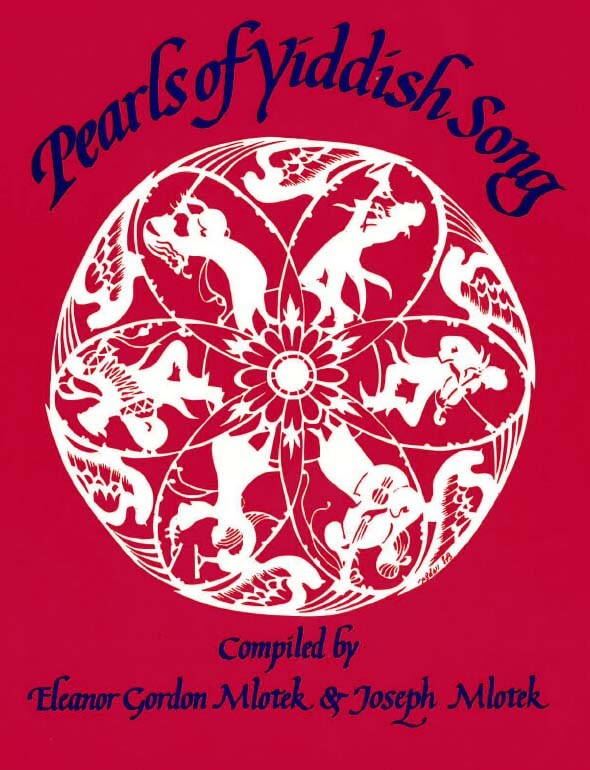Humorous song about the languages a Jewish child in Warsaw must speak. Words by the poet Avrom Reyzen (1875-1953). Originally titled “A bild fun di tsente yorn in varshe” (A picture of Warsaw in the 1910’s); In some collections the song is titled “Yorn dray-shprakhn fir” (Three years old-four languages). The song was sung by compiler Yosl Mlotek in Warsaw in the 1930’s.
Words and melody were published by Kh. Poznyak in 1974 in Tel Aviv. There the governess is English-speaking. A similar melody is used in Shmerke Kaczerginski’s 1948 collection of ghetto songs for the song “Tsvey brigades” (Two Brigades) by Leah Svirski.

This is a golden child
who plays as free as a bird.
What does he have to worry about,
when he is three years old?
The only trouble is with languages
languages without end
The child is only three years old
and speaks four of them.
His mother is Russian,
that is, from Lithuania,
So she talks to him in Russian
that’s what she is used to.
The nanny is Polish,
how else could it be?
So the child must struggle
to be polite in Polish.
His grandmother is Jewish
and speaks to him in Yiddish,
so the child answers her chatter in kind,
how could he do otherwise?
His father is a Zionist,
a fan of Akhad Ha’om,
So the child must greet him
by saying “Shalom” to him!
Listen, my dear child,
I feel for you.
Do you think you will get away
with only four [languages]?
They’re looking for a governess
for you, a German, and that will do it!
Then you will grow up, my child,
as clever as your parents.
note: Akhad Haom = Ahad Ha’am. Pen name of Asher Zvi Hirsch Ginsberg (1856-1927).
A kind iz dos a goldene,
Un shpilt zikh frank un fray,
Un vos far a dayges hot es den,
Az yorn hot es dray?
A tsore mit di shprakhn nor,
Shprakhn on a shir,
Yorn hot dos kind nor dray,
Un shprakhn hot es fir.
Di mame iz a rusishe,
A litvishe gemeynt,
Dan redt zi mit im rusish nor,
Azoy iz zi geveynt.
Di nyanye iz a poylishe,
Vi ken dos andersh zayn?
Muz dos kind zikh matern,
Oyf poylish heflekh zayn.
Di bobe iz a yidishe
Un redt mit im zhargon,
Dan muz dos kind ir nokhplaplen,
Vi ken es andersh ton?
Der tate iz a tsionist,
Un halt fun Akhad Haom,
Muz dos kind bagrisn im
Un zogn im: Shalom!
Her nor, du, mayn libes kind,
Mir zol zayn far dir,
Du meynst, az du vest opkumen
Nor mit shprakhn fir?
Men zukht a guvernantke dir,
A daytshke un genug,
Vestu, kind mayns, oysvaksn
Vi tate-mame klug. . .
אַ קינד איז דאָס אַ גאָלדענע,
און שפּילט זיך פֿראַנק און פֿרײַ,
און װאָס פֿאַר אַ דאגות האָט עס דען,
אַז יאָרן האָט עס דרײַ?
אַ צרה מיט די שפּראַכן נאָר,
שפּראַכן אָן אַ שיעור,
יאָרן האָט דאָס קינד נאָר דרײַ
און שפּראַכן האָט עס פֿיר.
די מאַמע איז אַ רוסישע
אַ ליטװישע געמײנט,
דאַן רעדט זי מיט אים רוסיש נאָר,
אַזױ איז זי געװײנט.
די ניאַניע איז אַ פּױלישע,
װי קען דאָס אַנדערש זײַן?
מוז דאָס קינד זיך מאַטערן,
אױף פּױליש העפֿלעך זײַן.
די באָבע איז אַ ייִדישע
און רעדט מיט אים זשאַרגאָן,
דאַן מוז דאָס קינד איר נאָכפּלאַפּלען,
װי קען עס אַנדערש טאָן?
דער טאַטע איז אַ ציוניסט,
און האַלט פֿון אחד־העם,
מוז דאָס קינד באַגריסן אים
און זאָגן אים: שלום!
הער נאָר, דו, מײַן ליבעס קינד,
מיר זאָל זײַן פֿאַר דיר,
דו מײנסט, אַז דו װעסט אָפּקומען
נאָר מיט שפּראַכן פֿיר?
מען זוכט אַ גוּװערנאַנטקע דיר,
אַ דײַטשקע און גענוג,
װעסטו, קינד מײַנס, אױסװאַקסן
װי טאַטע־מאַמע קלוג. . .
Song Title: A Kind A Goldene

First published in 1988 as Pearls of Yiddish Song: Favorite Folk, Art and Theatre Songs, this anthology contains 115 songs. Some material had never been published, while others, included in rare song collections or sheet music, were largely inaccessible. The songs presented reflect Jewish life in Eastern Europe and the United States and depict childhood, love, family celebrations, poverty, work and struggle. There are also songs from the Hasidic and Maskilic movements, songs of Zion and of America, as well as songs from the Yiddish theater.
The title of this anthology derives from the weekly two-page feature column “Pearls of Yiddish Poetry,” which the compilers Yosl and Chana Mlotek initiated in 1970 in the Yiddish newspaper Der Forvertz (the Yiddish Daily Forward). Hundreds of readers from around the world — including authors, composers, singers, actors — became co-participants in this collective folk project and recalled melodies, lines, fragments, stanzas and their variants of songs, poems, and plays which they had heard in their youth. At first, readers sent in only written material. Later, they also taped songs on cassettes, many of whose melodies had, until then, never been recorded. They also identified and supplied missing information regarding lyricists, poets, and composers and described the circumstances surrounding the songs’ origins, their dissemination, diffusion and impact.